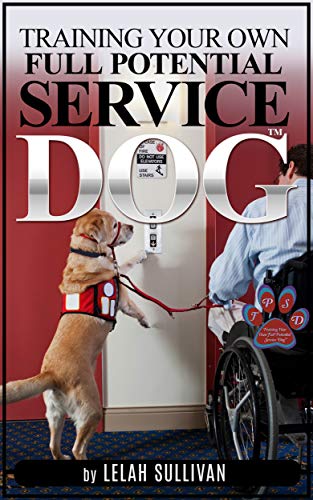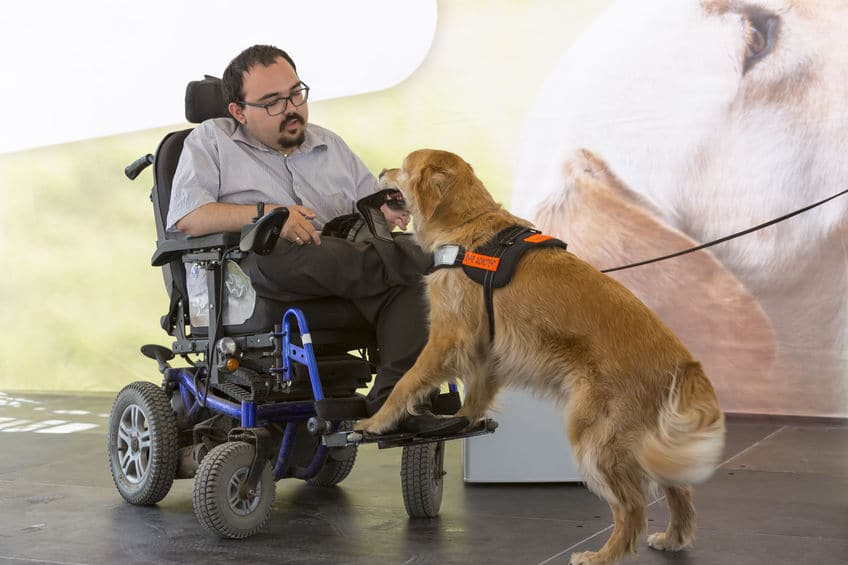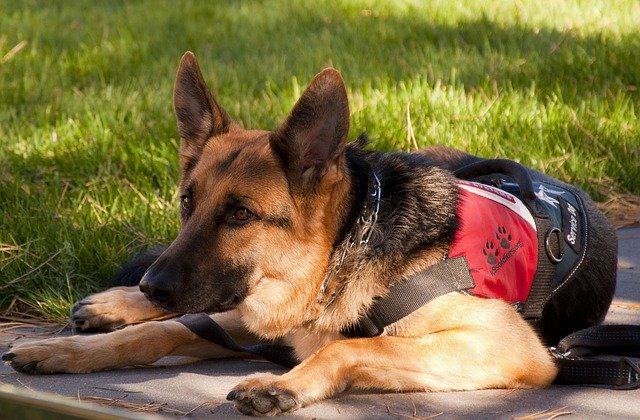Process of a Pup to Become a Service Dog
- This post contains affiliate links. Read more here.
All dog lovers know how special the bond can be between a dog and his owner, but service dogs take that relationship to a whole new level. Service dogs provide their companions with a quality of life that would not be possible without their assistance, making them truly man's best friend.
Sadly, however, not all people who need a service dog can get one from an organization specializing in training them. What many people don't know, however, is that for some needs and circumstances, it is possible to train your dog to be a service dog.

This, of course, depends on your dog, your ability to train him or hire a professional trainer, and your particular disability.
What is a service dog?
The Americans with Disabilities Act (ADA) defines a service dog as a dog who has been trained to perform tasks to benefit a person with a disability. This can range anywhere from blindness to autism to PTSD.
A service dog is usually trained to meet very individualized requirements for their companion. Because they're trained to such a high degree, service dogs can be expensive and the waiting lists for a perfect match can be long…as in years long.
In fact, these highly trained and specialized dogs often have corporate sponsors and are sometimes associated with charities, which can defray the costs, but the need often outstrips how much help there is out there.
Unfortunately, the combination of the waiting list, the expense, and the matching process can make a specially trained service dog out of some peoples' reach, even though they would benefit greatly from having a service dog in their life. To learn more about service dogs, take a look at our guide on getting a service dog.
I Can't Afford a Service Dog, What Are My Options?
Believe it or not, many people have seen success in training their own service dog. It depends on the disability being accommodated, the temperament of your dog, and several other factors, but it can be done.
One resource that prospective service dog trainers have found helpful is this guide to get you started:

Training Your Own Full Potential Service Dog, by Lelah Sullivan comes highly rated, and is noted by reviewers as being a great place to start your training journey.
Read on for more details on training your own service dog.
Can My Dog Be a Service Dog?
Before you can train your dog to be a service dog, there are a few criteria to be aware of. Not all dogs are capable of being effective service dogs, and trying to train a dog that isn't cut out to be that kind of working dog is a recipe for unhappiness for both of you.
When assessing your dog, keep the following things in mind:
How old is your dog?
An inaugural visit to the vet (with regular checkups) is important: health conditions like arthritis and diabetes put an undue strain on the best of pets, so adding service animal responsibilities is unwise.
All service dogs should also be neutered so that males are less aggressive and females don't face working when in heat. Dogs should be at least 6 months old and past the puppy phase, too.
What's your dog's temperament?
Some dogs are aggressive while others are submissive, and in many cases, this isn't "good" or "bad"—it's not that simple. The right temperament for a service animal is a very narrow margin between these two poles.
If your dog is calm, cool, and collected, but also alert and responsive, chances are she's a good fit for service work. Paw Rescue has a great primer on dog temperament, with additional resources for testing ideas.
What Breeds Make the Best Service Dogs?
Any breed! While breeds like golden retrievers, Labrador retrievers, and even German shepherds are popular as service dogs, any dog fitting the criteria can be the perfect assistant to those in need. It all comes down to the disability they are helping with, and what temperament they have.
The ideal service dog is:
- Calm
- Confident
- Intelligent
- Motivated
- Social (just not too social)
- Non-reactive
These are just a few criteria you can use to see if your dog has a good chance of becoming a great service dog. For more on determining a dog's temperament, take a look at our dog temperament guide. You can also arrange an assessment with the American Temperament Test Society.
It's also a good idea to be aware of what disability the dog is being trained to assist. Someone needing a dog to help them with balance may need a larger breed, while a small dog could make an excellent diabetes alert service dog.
Training Your Service Dog
Under the ADA you have the right to train your own dog. If you elect to go this route, your training should start similarly to how most dog training begins…with the very basics.
Even in professional training settings, service dog dropouts are extremely common because the skillset and temperament required can be hard to come by, but that doesn't mean you can't be successful.
Foundational skills for service dogs include socialization, housebreaking (think housebreaking-plus, as your dog should be able to potty on demand with specific commands), and familiarization with the world around them (shy or skittish dogs often are not suited to service dog life).
Start with these skills and build on your successes. Aiming for them to pass the Canine Good Citizen test is a great way to shape your training regimen.
After you have mastered the basics, you may want to consider some professional assistance, as the next series of tasks need to be mastered in order to ensure that your dog is reliable—even in unfamiliar situations like near cats, squirrels, and loud noises.
Your dog needs to be as well behaved off a leash as he is on a leash, and that is no simple task. Your dog also needs to respond to you first, and this means forgoing interacting with other people or animals he may meet during his daily activities.
According to USA Service Dogs, one way to train and test your dog's attentiveness to you is to work on his eye contact. Even when new people enter the scene, his focus needs to be on you. You can help him achieve this by enlisting a friend who agrees to ignore the dog if your dog tries to shift his attention from you.
If you can achieve the standards outlined above, you might be ready to start teaching your dog the specific tasks he will need to assist you with your disability.
These tasks will differ greatly across companions. According to USA Service Dogs, the key to achieving success in this step is to work on one concept at a time. Dogs can't process multiple new tasks at once, so start slow and build on the skills one at a time.
Consider making your tasks "dog friendly." For instance, if one task your dog will perform is bringing you your phone, make sure you have a case that your dog can pick up easily in his mouth, and be sure that your phone looks different from other phones he might encounter.
Don't be surprised when your dog starts taking his job seriously—if a friend borrows your phone when he's over at your house, your dog just may retrieve it from him!
It is important to take your training slow and steady, and ask for help if you need it. Training should take place in short sessions and should remain fun and engaging for your dog. If you find yourself getting frustrated or not making the progress you need, consider consulting with a professional trainer.
Service Dogs vs. Emotional Support Dogs
Service dogs and emotional support dogs have in the past been mistakenly treated as interchangeable, even though they have some fundamental differences.
While both types of dogs can provide great comfort and utility to their companions, service dogs are specifically trained to serve a function for their owners in public places. Emotional support dogs may have training or not, and their presence is usually enough to help their companions.
It's also very important to understand that a service dog is a working dog and because they are performing this very important function for one person, they are not a pet.

Guide and assistance dog- 123rf
A service dog helps a person with a disability Conversely, an emotional support dog is a wonderful companion who can provide great comfort to their owner but has not received individualized training that would qualify him to complete specific tasks for their owners.
Because of this very important difference, service dogs and their owners have certain rights in public spaces that companion dogs are not entitled to, such as the ability to accompany owners in all public spaces, with exceptions only if the dog cannot be controlled by his owner or if he is not housebroken, according to the ADA.
What About Service Dog Fraud?
Recently, the Veteran's Administration adopted some of the American Kennel Club standards for service dogs, as a way to cut down on service dog fraud—that is, people who try to pass untrained dogs off as service dogs.
This practice is detrimental to those who need service dogs and is harmful to educating the public as to the roles of a service dog and the genuine need for trained service dogs in our communities.
Types of Service Dogs
When we think of service dogs, we often picture German shepherds or labradors, but most dogs can make great service dogs, as the individual qualities of dogs can be matched with the wide variety of companion needs.
According to service dog certifications, any breed of dog is eligible to become a service dog—there are no weight or breed restrictions.

German Shepherd Service Dog – Pixabay
If you are looking to train your dog to become a service dog, after you have determined that your dog has the capabilities to assist you, you should consider your dog's health. Because service dogs are working dogs who will be dedicated to caring for their companion, it is important that they are up to the job.
Have your veterinarian do a full assessment of your dog. Another big consideration will be your dog's age. Your dog should be old enough to enter into formal training, but young enough that you can rely on him for many years of service after his training is complete.
Do I Need to Register my Service Dog?
The ADA does not require you to register your service dog. In fact, the ADA has guidelines for what business owners can ask you related to your dog and disability. If your disability is not obvious, a business or employee can only ask these two questions:
- Is the service animal required because of a disability?
- What work or task has the dog been trained to perform?
That's it. They cannot require you to produce a training certificate, registration or ask anything specific about your disability.
You can choose to identify your dog as a service dog by using a harness that identifies his special status. Many dogs are trained using their harness and understand that when the harness is on, it's time to work, and when the harness is off, it's time to rest.
Using a harness can help your dog understand his role. Additionally, it helps to educate the public that your service dog is a working dog and not a pet, and therefore should not be distracted, pet, or played with while he is working.

However you choose to start your journey with a service dog—whether you use a service, a trainer, or embark on the training adventure yourself, remember that the ADA does not require any special training or program for service dogs.
Your particular needs will help you determine what the best route is for you. The ADA offers further protections as well, such as the questions businesses are allowed to ask about disability, and where and when your service dog can accompany you (and the answer is almost always everywhere.)
Further Reading
Interested in learning more? Check out these Rover.com articles on service dogs.
- Gaining Mobility with a Service Dog: How Trained Animals Can Save Your Life
- How Service Dogs Help Humans with Diabetes
- Your Top Questions About Service Dogs, Answered
Process of a Pup to Become a Service Dog
Source: https://www.rover.com/blog/become-service-dog/
0 Response to "Process of a Pup to Become a Service Dog"
Postar um comentário